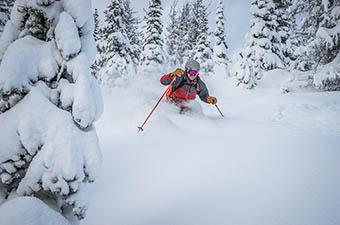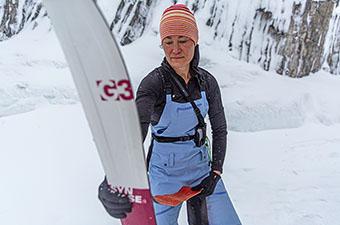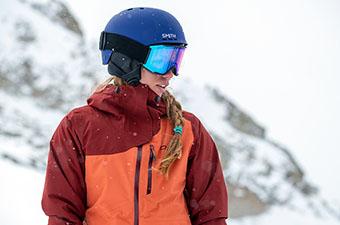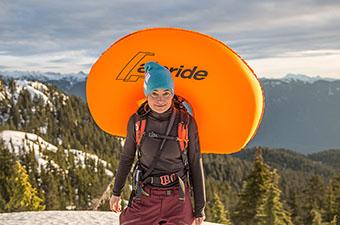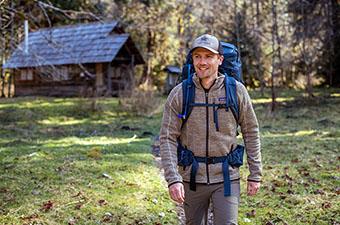Ortovox Diract Voice
Price: $450
Weight: 7.4 oz.
Maximum range: 50m
Battery life: 200 hours+
What we like: Incredibly intuitive and easy to use with helpful voice commands and a rechargeable battery.
What we don’t: Middling search range, no analog mode, and a couple more voice commands would be helpful.
See the Ortovox Diract Voice
Backcountry skiing has exploded in recent years, and avalanche safety technology has followed suit with plenty of easy-to-use beacons. Released last year to quite a bit of fanfare, Ortovox’s Diract Voice is one of the most inventive options on the market: The built-in voice commands effectively guide users through the search process, while the rechargeable lithium-ion battery adds a nice boost in convenience and eliminates the need to pack extra alkalines. We put the Diract Voice through a full winter of testing, including 50+ mock-burial scenarios, and came away impressed by its unique features and all-around performance. Below we outline our experiences with the Diract Voice. To see how it stacks up to the competition, see our article on the best avalanche beacons.
Editor’s note: There are inherent risks to traveling in avalanche terrain, and we do not condone the use of a beacon—or any avalanche safety tools—without proper education. Visit the American Avalanche Association’s website to learn more and sign up for a Level 1 avalanche class.
Table of Contents
- Set-up
- Ease of Use
- Performance: Mock Burials
- Weight, Size, and Wearability
- Key Design Features
- What We Like/What We Don’t
- Comparison Table
- The Competition
Set-up
While many avalanche beacons simply require adding batteries and powering on to start using, the Ortovox Diract Voice needs to be charged and set up before heading into the field. The good news is that the process is relatively simple (Ortovox provides a helpful breakdown here), and downloading the Ortovox app on your smartphone is a great place to start: Scanning the provided QR code will bring you to the download page, and from there you can register your device, check for software updates (the device updates automatically), and even extend the warranty from two to five years at no added cost. The Bluetooth capability also makes it easy to dig into advanced settings and play around with the beacon’s functionality, although it’s certainly not a must-have for most.![]()
The next step is calibration, and the Diract Voice does a nice job instructing you as it calibrates the electronic compass. It’s very similar to calibrating a GPS device and involves holding the beacon horizontally and rotating it several times in different directions. Once calibration is complete, the Diract Voice will automatically perform a “self test” each time you turn it on and warn you if the battery is running low—Ortovox recommends charging anytime the battery falls below 40%. Charging is relatively quick via the included USB-C cable (most competitors run off of AA or AAAs). To wrap up the setup process, you’ll want to attach the elastic tether to the device. While out in the field, it’s always a good idea to keep the beacon attached to you in some way, whether secured in the included chest harness or attached to a beacon clip on your ski pants or bibs.![]()
Ease of Use
Avalanches are high-stress and high-consequence situations with little room for error, and the Ortovox Diract Voice helps mitigate potential issues with a simple and easy-to-use interface. The front of the device features just two buttons—power and flag—but the hallmark feature is the voice navigation that instructs users with clear, concise directions during the search phase. Below we outline each step of the process, from powering on to switching modes and following both the voice and on-screen instructions.
Powering On and Group Check
The first step in using the Ortovox Diract Voice is turning the device on by pressing and holding the power button hidden behind the search tab at the back for two seconds (turning it off requires pushing both the power and flag buttons). At this point, the device will prompt a group check, which you can initiate by hitting the flag button on the front of the beacon. If you forgo a group check, the Diract Voice will automatically go into send (transmit) mode.![]()
Search, Send, and Standby Modes
Switching from send to search mode is quick and easy, even when wearing bulky ski gloves: Simply flip the bright orange tab at the top the beacon. For reference, we tested the Diract Voice alongside Mammut’s Barryvox S and found the Ortovox far simpler to operate. By comparison, the Mammut requires pressing a button while simultaneously sliding the adjacent bar to the right to enter search mode, which can be difficult to do with gloved hands. This also makes it easy to overshoot and end up in the wrong mode, which can eat up critical seconds in a time-sensitive situation. With the Diract Voice, there’s no question which mode you're in.![]()
In addition to search and send, there’s also a helpful “standby” function that temporarily stops the Diract Voice from both transmitting and receiving. This can be helpful in teaching environments as well as complex rescue scenarios when being in another mode might confuse or further complicate search efforts. To enter standby, simply press the flag button at the front of the device.![]()
Voice Assistance
The Ortovox Diract Voice’s calling card is its integrated voice navigation, which consists of helpful verbal commands to direct your beacon search. There are nine available languages to choose from, and the beacon provides clear, simple instructions from the moment you switch from send to search. Examples of commands include: “Run in 50-meter search strips and look out,” “run straight,” “keep left/right,” “turn around,” “go down to the snow surface,” and more. ![]()
Importantly, the distance and direction to the nearest victim’s transmitting signal are clearly displayed on the screen at all times, but the voice commands allow you to keep your eyes on the scene instead of being fixated on the device. In mock scenarios, we found that the directions were loud enough to hear clearly, easy to understand, and effectively communicated what to do and when. All told, I’ve concluded that if we were buried, we would feel safer and more confident if my partners were being directed by the Diract Voice, which is truly high praise and says a lot about the device’s intuitive, straightforward commands.
Display Screen
As we mentioned, the Diract Voice’s verbal instructions are accompanied by corresponding visuals on the screen. In addition to reinforcing the voice commands with directional arrows and distance measurements, the screen also clearly displays the number of potential and/or flagged victims (up to four) in the bottom left corner. Importantly, the screen is adequately sized at 1.3 x 1.8 inches and easy to read, and you can adjust brightness via the mobile app, which is particularly helpful for mitigating snow glare. The screen does go into “sleep” mode to save power when not in use, but pressing either the power or flag button will quickly illuminate it.![]()
Performance: Mock Burials
It’s tough to evaluate a beacon’s performance without using it in a real emergency situation, so we assembled some mock burials to mimic how the Ortovox Diract Voice would fare in an actual avalanche. Overall, we were very impressed by the beacon’s ease of use, although we did have some nitpicks in multiple-burial scenarios, which we outline below. The 50-meter search range is also on the shorter end compared to the competition, although the verbal commands helped considerably with keeping us on the right track and reliably leading us to our “victims'' each time.
Searching
Once the top tab is flipped open, the Diract Voice quickly enters search mode and begins guiding you to the nearest transmitting beacon with voice commands. Even in our mock simulations, it was incredibly helpful being reminded of the basics (e.g., “run in 50-meter search strips,” or “go down to the snow surface”), and the ability to look up while searching was a huge advantage when navigating rough terrain or looking for clues. I imagine the voice commands would be even more impactful in a real avalanche scenario, and particularly for those new to avy rescue—studies have shown that in an emergency, voice cues can be processed more quickly than visual cues.![]()
All that said, the verbal cues aren’t entirely comprehensive. Though the device declares the switch to send mode, there’s no audible indication when you enter search mode—it simply starts providing verbal instructions. Further, when approaching a nearby beacon, it also doesn’t let you know when to start your fine search. Instead, the screen displays the approximate distance to the burial (similar to most other avalanche beacons), and the searcher must have basic recovery and fine-search knowledge (e.g., probing and shoveling) in order to complete the rescue.
A final note unrelated to the voice commands: Cellphones and other electronics can interfere with the Diract Voice, particularly during search and even if you’ve turned on “airplane mode.” This isn’t an issue specific to the Ortovox—our Mammut Barryvox S experienced similar interference problems during testing—but it’s important to remember when you’re in the field. If you don’t want to turn off your phone, our recommendation is to keep it stashed in your pack as far away from your beacon as possible (Ortovox recommends a distance of at least 8 in. in transmit and standby modes and 20 in. in search).
Single Burials
The Ortovox Diract Voice performed well during single-burial rescue scenarios involving one "victim," although the 50-meter search range is on the shorter end compared to many top-of-the-line models. While conducting 50-meter search strips, the Diract Voice tended to detect the victim within 30 to 40 meters, while our Mammut Barryvox S (with a 70m maximum range and 95m in analog mode) picked up the signal about 50 meters away. To be fair, most avalanche instructors teach search patterns based on a 40-meter radius, which is also the range in which beacons become most reliable. You might start to get a signal from farther away, but it is still likely to bounce around or disappear and come back depending on which direction you’re facing. And once our victim was within range, the Diract Voice provided clear instructions that led us directly to the burial. If we veered off course, the device quickly corrected us and got us back on the right track. ![]()
Multiple Burials and Flagging
Like most modern beacons, the Ortovox Diract Voice has a multiple-burial indicator that allows it to detect more than one transmitting signal (i.e., more than one victim). Once the first victim has been located, you can “flag” their location by pressing the button on the front of the device, prompting the Diract Voice to temporarily suppress that signal and continue looking for other transmitting beacons (it can locate up to four). This allows searchers to divide resources while continuing to look for more victims. It’s worth noting that there’s a slight delay after pressing the flag button before the Diract Voice continues providing voice guidance, although it’s not significant at less than 5 seconds (and our Mammut Barryvox S has a similar lag between flagging and resuming search).![]()
We performed 50+ mock-burial scenarios with the Ortovox Diract Voice and were able to locate both victims in all of our tests, although some went less smoothly than others. In the end, we found that the device was most accurate in situations when the burials were in close succession distance-wise, but it got a little jumbled when the victims were scattered farther apart and when we were positioned equidistant from two separate burials. To be fair, a large part of this is due to the inherent complexity of having to locate more than one victim at a time, and slowing down your search will allow the beacon to separate the signals. That said, we do think that more voice commands to indicate multiple burials (rather than just an icon on the screen) would help make the process a little more seamless—especially in a real, high-stress backcountry emergency.
Weight, Size, and Wearability
The Diract Voice is lightweight at 7.4 ounces (the carrying strap adds another 2.8 oz.) and relatively compact at around 4.7 inches tall, 3.1 inches wide, and 0.9 inches thick. For reference, the Mammut Barryvox S weighs the same and is a little smaller in terms of length and width (4.5 x 2.6 in.), but the thicker (1.1-in.) profile is noticeable when stashed in a chest harness or ski pant pocket. Skimo racers, ski mountaineers, and other weight-conscious backcountry-goers can go even lighter and more compact with options like the BCA Tracker S (5.8 oz.), Black Diamond Recon LT (5.6 oz.), or PIEPS Micro BT Sensor (5.3 oz.). But in general, size and weight doesn’t vary too much between models, and most beacons, including the Diract Voice, are small enough to fit in your hand and light enough to go unnoticed during all-day tours.![]()
As far as wearability goes, the Diract Voice’s included chest harness is a real highlight and more comfortable than other designs we’ve tested. The strap is highly adjustable and secure, with basic webbing around the waist and a well-padded shoulder strap that doesn’t dig into the skin. Removing the beacon is also quick and easy—it’s held in place with a Velcro strap that pushes the device out several inches for quick removal when pulled. Once exposed, the beacon’s textured, rubberized sides are easy to grip, even with one hand and when wearing ski gloves. On the other hand, some prefer to store their beacon in a ski pant or bib pocket, and the Diract Voice’s include elastic tether makes this easy.![]()
Key Design Features
Rechargeable Battery
Most avalanche beacons run off of alkaline (AA or AAA) batteries, but the Diract Voice bucks that trend with a rechargeable lithium-ion battery. The benefits are threefold: In addition to creating less waste over time and eliminating the need to pack extra batteries, the lithium-ion battery doesn’t leak. We’ve forgotten to remove alkaline batteries from our beacons at the end of the season before only to find them corroded the following winter, which can permanently damage the device.
Importantly, the Diract Voice’s battery is also designed for use in cold temperatures—Ortovox states that it will work in temps down to -4˚ Fahrenheit—and lasts up to 200 hours in transmit mode. For most users, this will be enough to get through an entire winter (Ortovox recommends charging the battery once it goes below 40%). It’s worth noting that many alkaline-equipped competitors last around 250 to 300 hours, but that’s still a lot of juice on a single charge. If the battery is running low, the Diract Voice will notify you with a percentage icon clearly displayed on the screen, and it's easy (and fast) to recharge via the USB-C port at the side. It will also notify you if there’s an issue with the battery with an on-screen prompt to service the device.![]()
Antenna System
We’re admittedly not experts on the intricacies of avalanche beacon antennas and won’t dive too deep into the nitty gritty, but there are some basics to be aware of. First, it’s important to note that all modern beacons (including the Diract Voice) operate digitally using three antennas. During search, all three antennas are used: The X and Y antennas hone the range and direction, while the Z antenna helps direct you in the final few meters. Some higher-end models (like the Mammut Barryvox S) have analog modes as well, which allows them to pick up transmitting signals from farther away through the use of audio transmissions. The Diract Voice doesn’t have this option, but that likely won’t make a huge difference in a stressful real-life scenario, and the digital interface is much faster and easier to use.
The Diract Voice also utilizes Ortovox’s innovative Smart-Antenna Technology, which automatically determines the device’s orientation and switches to the antenna with the best transmission in the event of an avalanche. For comparison, beacons without this tech can send only over the X antenna (a single axis), while the Diract Voice can send over both the X and Y antennas (perpendicular axes). This extends the victim’s transmission range considerably (up to double) and makes them much quicker and easier to find. For more information on antennas and the Smart-Antenna Technology, we found this graphic from Ortovox to be very helpful.
Additional Safety Features
In addition to the Smart-Antenna Technology, the Ortovox Diract Voice boasts several other helpful safety features. For starters, there’s a Recco reflector hidden in the harness, which is a supplementary, passive device that emits a signal for rescuers to locate. The Diract Voice is also waterproof, performs routine self-tests and software updates via the app, and automatically switches from search or standby to transmit mode if you’re stationary for at least 90 seconds (a nice dose of assurance in the case of a secondary avalanche). The orange tab at the top also covers the power button to reduce the chance of accidentally turning off the device (you also need to hit the flag button to power it off). My only complaint is that the tab can accidentally be flipped from send to search mode under tension, which is something to be aware of if you store your beacon in a pocket (the included chest harness doesn’t have anything that the tab can catch on).![]()
Other Versions of the Ortovox Diract
In addition to the Diract Voice beacon tested here, Ortovox released a few other products under the Diract name. First is the standard Diract transceiver, which costs $60 less, forgoes the built-in voice commands, and has a smaller and more basic screen. Most other features remain, including the rechargeable lithium-ion battery, Ortovox’s Smart-Antenna Technology, a 50-meter maximum search range, and handy chest harness. Rounding out the collection, Ortovox offers three kits that include a beacon, shovel, and probe for those just getting started: the $450 Rescue Set Diract, $510 Rescue Set Diract Voice, and $530 Rescue Set Diract Voice Light. Only the latter two include the voice-equipped model, with the only notable difference being the design and weight of the shovel.
What We Like
- Voice commands provide a convenient and intuitive search experience: They’re clear, easy to follow, and allow you to keep your eyes on the scene.
- Lithium-ion battery eliminates the need to pack alkaline batteries, doesn’t leak, has a reasonably long life, works well in the cold, and is easy and fast to recharge via USB-C.
- Included chest harness is secure, comfortable with a well-padded shoulder strap, and makes it easy to retrieve the beacon quickly—even when wearing gloves.
- Light at 7.4 ounces and compact enough to easily fit in most ski pant/bib pockets.
- Bluetooth connectivity and seamless integration with the Ortovox app, which provides automatic software updates and the ability to customize settings.
What We Don’t
- The 50-meter search range is on the shorter end compared to the competition.
- No analog mode, which would allow the beacon to pick up transmitting signals from farther away.
- We wish there were voice commands to indicate multiple burials, confirm the switch to transmit mode, and guide you through the fine search.
- Top tab can get caught on gear and flip from send to search mode accidentally (we recommend using the chest harness to prevent this).
Comparison Table
| Beacon | Price | Weight | Range | Battery | Battery Life | Bluetooth |
|---|---|---|---|---|---|---|
| Ortovox Diract Voice | $450 | 7.4 oz. | 50m | Lithium-ion | 200 hours+ | Yes |
| Backcountry Access Tracker3 | $350 | 7.6 oz. | 55m | 3 AAA | 250 hours | No |
| Mammut Barryvox S | $550 | 7.4 oz. | 70m | 3 AAA | 300 hours | No |
| Black Diamond Guide BT | $500 | 7.9 oz. | 60m | 3 AAA | 400 hours | Yes |
| PIEPS Micro BT Sensor | $390 | 5.3 oz. | 50m | 1 AA | 200 hours | Yes |
The Competition
Ortovox’s Diract Voice is one of the most user-friendly avalanche beacons on the market, but not everyone needs the built-in voice commands. If they’re not a must-have for you, there are plenty of other options to choose from, including Backcountry Access’ popular Tracker3. Like the Diract Voice, the Tracker3 has an intuitive interface and checks all the boxes for recreational users, including a longer battery life (250 hours in transmit), competitive signal range (55m vs. 50 for the Ortovox), and all of the requisite safety features. It’s similarly light at 7.6 ounces, has a slim and pocket-friendly shape, and comes with a carrying case and chest harness. We also appreciate that the Tracker3 indicates if multiple burials are in close proximity, although the flagging function is limited (it can only suppress one signal and only for a minute). Finally, you trade the Ortovox’s rechargeable battery for standard AAAs, but the BCA’s reliable all-around performance at a full $100 cheaper makes it a highly competitive option.
Next up is Mammut’s Barryvox S, which we tested alongside the Diract Voice. The Barryvox S is the better option for advanced users like ski guides, patrollers, and avy professionals, with a longer maximum search radius (70m) and the option to switch to analog mode to increase range (up to 95m). You also get the choice between alkaline or lithium batteries, both of which last longer than the Ortovox’s rechargeable design (300-400 hours). Finally, the Barryvox tacks on state-of-the-art features like a U-turn indicator to keep searchers moving in the right direction, customizable settings, and a clear visual interface with intuitive, animated instructions. But the Barryvox’s sliding bar makes it tougher to switch from send to search mode, and its thicker profile isn’t as pocket-friendly as the low-profile Ortovox. It’s also $100 pricier and overkill for most recreational users, although the added functionality is a notable advantage for complex rescue scenarios.![]()
Neither the BCA nor the Mammut includes Bluetooth connectivity, but if this modern feature appeals to you, Black Diamond’s Guide BT is worth having on your radar. Like the Barryvox S, the Guide BT is an advanced model that’s best suited for experienced backcountry-goers and professionals. You still get a simple interface that prioritizes ease of use, but with upgraded features like a longer battery life and range (400 hours and 60m respectively), analog functionality, and even an integrated inclinometer for measuring slope angle. Again, you don’t get the built-in voice commands for guiding you during search, but the Guide does vibrate when it detects a signal, which allows you to take your eyes off the beacon to look for clues like strewn gear and clothing. Not everyone needs this level of complexity—beginners will likely prefer the Diract Voice for the more intuitive experience—but the Guide BT is a more premium and fully featured option for just $50 more. For a step down in features, check out BD's new Recon X.![]()
Last but not least is the PIEPS Micro BT Sensor, which is touted as the smallest and lightest three-antenna beacon currently on the market. Despite costing $60 less and checking in around 2 ounces lighter than the Diract Voice, the Micro BT’s feature set lines up pretty well: Both beacons have a 50-meter search range, 200-hour battery life (the PIEPS runs off of one AA battery), and include features like a flagging function, large LED screen, and Bluetooth compatibility. That said, the Micro BT uses a proximity sensor rather than a standard switch to alternate between transmit and search modes depending on the beacon’s position in your hand or harness, which leaves room for error and doesn’t do much to improve overall convenience (flipping the Ortovox’s tab is quick and easy). In the end, the PIEPS has its place for committed skimo racers, ski mountaineers, and other weight-conscious backcountry users, but the Diract Voice is the more intuitive, complete design and still plenty light and compact for most.
If you’re thinking about buying gear that we’ve reviewed on Switchback Travel, you can help support us in the process. Just click on any of the seller links above, and if you make a purchase, we receive a small percentage of the transaction. The cost of the product is the same to you but this helps us continue to test and write about outdoor gear. Thanks and we appreciate your support!
Depending on the seller, most products ship free in the United States on orders of $50 or more. International shipping availability and rates vary by seller. The pricing information on this page is updated hourly but we are not responsible for inaccuracies.


